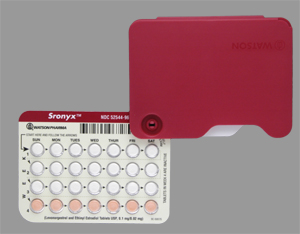Sronyx and Alcohol/Food Interactions
There are 10 alcohol/food/lifestyle interactions with Sronyx (ethinyl estradiol / levonorgestrel).
Ethinyl Estradiol Caffeine
Moderate Drug Interaction
Consumer information for this interaction is not currently available.
MONITOR: Coadministration of ethinyl estradiol may increase the plasma concentrations of drugs that are primarily metabolized by CYP450 1A2. In a study of 30 healthy volunteers administered the CYP450 1A2 substrate tizanidine, the systemic exposure (AUC) of tizanidine was 3.9 times greater in women using an oral contraceptive containing ethinyl estradiol.
MANAGEMENT: Patients should be monitored for increased adverse effects of the CYP450 1A2 substrate during concomitant use with ethinyl estradiol. Product labeling for the specific CYP450 1A2 substrate should be consulted for additional recommendations.
Ethinyl Estradiol Alcohol (Ethanol)
Minor Drug Interaction
Information for this minor interaction is available on the professional version.
Levonorgestrel Alcohol (Ethanol)
Minor Drug Interaction
Information for this minor interaction is available on the professional version.
Levonorgestrel Food/Lifestyle
Moderate Food Interaction
Consumer information for this interaction is not currently available.
MONITOR: Grapefruit juice may increase the plasma concentrations of orally administered drugs that are substrates of the CYP450 3A4 isoenzyme. The proposed mechanism is inhibition of CYP450 3A4-mediated first-pass metabolism in the gut wall by certain compounds present in grapefruit. Because grapefruit juice inhibits primarily intestinal rather than hepatic CYP450 3A4, the magnitude of interaction is greatest for those drugs that undergo significant presystemic metabolism by CYP450 3A4 (i.e., drugs with low oral bioavailability). In general, the effect of grapefruit juice is concentration-, dose- and preparation-dependent, and can vary widely among brands. Certain preparations of grapefruit juice (e.g., high dose, double strength) have sometimes demonstrated potent inhibition of CYP450 3A4, while other preparations (e.g., low dose, single strength) have typically demonstrated moderate inhibition. Pharmacokinetic interactions involving grapefruit juice are also subject to a high degree of interpatient variability, thus the extent to which a given patient may be affected is difficult to predict.
MANAGEMENT: Patients who regularly consume grapefruit or grapefruit juice should be monitored for adverse effects and altered plasma concentrations of drugs that undergo significant presystemic metabolism by CYP450 3A4. Grapefruit and grapefruit juice should be avoided if an interaction is suspected. Orange juice is not expected to interact with these drugs.
Ethinyl Estradiol Food/Lifestyle
Minor Food Interaction
Information for this minor interaction is available on the professional version.
Switch to professional interaction data
Ethinyl Estradiol High Blood Pressure (Hypertension)
Major Potential Hazard, High plausibility
estrogens - hypertension
The risk of myocardial infarction and strokes, including those associated with oral contraceptive use and some estrogen use, is increased in patients with hypertension. Moreover, estrogens (and progestogens) may elevate blood pressure and worsen the hypertension, thus compounding the risk. Clinically significant blood pressure increases have been reported during estrogen therapy, particularly in patients receiving high dosages or treated with oral contraceptive combinations having high progestational activity. These effects also increase with duration of therapy and patient age. Therapy with estrogens should be administered cautiously in patients with preexisting hypertension. Some estrogen-based therapies, such as combined hormonal contraceptives, may be contraindicated in patients with uncontrolled hypertension or hypertension with vascular disease. Patients should be monitored for changes in cardiovascular status, and their antihypertensive regimen adjusted or estrogen therapy withdrawn as necessary. In patients requiring contraception, alternative methods should be considered for those who are hypertensive, over age 35, and smoke.
Ethinyl Estradiol High Cholesterol (Hyperlipoproteinemia, Hypertriglyceridemia, Sitosterolemia)
Moderate Potential Hazard, Moderate plausibility
estrogens - hyperlipidemia
Estrogens may cause adverse lipid changes. Use of estrogens has been associated with elevations in triglyceride levels, particularly in women with pre-existing hypertriglyceridemia. Discontinue therapy if elevated triglycerides lead to pancreatitis. Manage hypercholesterolemia appropriately as indicated.
Levonorgestrel High Blood Pressure (Hypertension)
Moderate Potential Hazard, Moderate plausibility
estrogens/progestogens - fluid retention
Estrogens and progestogens may cause fluid retention, particularly when given in high dosages or for prolonged periods. Therapy with these agents should be administered cautiously in patients who have preexisting problems with excess fluid. In addition, patients with conditions that may be adversely affected by fluid accumulation, such as asthma, epilepsy, migraine, and cardiovascular or renal dysfunction, should be observed for exacerbation of their condition during estrogen and/or progestogen therapy.
Levonorgestrel High Cholesterol (Hyperlipoproteinemia, Hypertriglyceridemia, Sitosterolemia)
Moderate Potential Hazard, Moderate plausibility
progestogens - hyperlipidemia
Some progestogenic agents may elevate plasma LDL levels and/or lower HDL levels, although data have been inconsistent. Patients with preexisting hyperlipidemia may require closer monitoring during progestogen therapy, and adjustments made accordingly in their lipid-lowering regimen.
Levonorgestrel Obesity
Minor Potential Hazard, Moderate plausibility
progestogens - weight gain
Progestogens can cause weight gain, which may be significant (as is the case with parenteral medroxyprogesterone) and undesirable in obese patients attempting to lose weight.
Switch to professional interaction data
Sronyx drug interactions
There are 501 drug interactions with Sronyx (ethinyl estradiol / levonorgestrel).
Sronyx disease interactions
There are 22 disease interactions with Sronyx (ethinyl estradiol / levonorgestrel) which include:
- smoking
- abnormal genital bleeding
- abnormal vaginal bleeding
- carcinomas (estrogenic)
- hypercalcemia in breast cancer
- hypertension
- thromboembolism/cardiovascular
- hepatic neoplasms
- breast malignancy
- liver disease
- angioedema
- gallbladder disease
- hyperlipidemia
- liver disease
- melasma
- depression
- fluid retention
- glucose intolerance
- thyroid function tests
- cardiovascular disease
- hyperlipidemia
- weight gain
More about Sronyx (ethinyl estradiol / levonorgestrel)
- Check interactions
- Compare alternatives
- Reviews (228)
- Drug images
- Side effects
- Dosage information
- During pregnancy
- Drug class: contraceptives
Related treatment guides
Drug Interaction Classification
| Highly clinically significant. Avoid combinations; the risk of the interaction outweighs the benefit. | |
| Moderately clinically significant. Usually avoid combinations; use it only under special circumstances. | |
| Minimally clinically significant. Minimize risk; assess risk and consider an alternative drug, take steps to circumvent the interaction risk and/or institute a monitoring plan. | |
| No interaction information available. |
See also:
Further information
Always consult your healthcare provider to ensure the information displayed on this page applies to your personal circumstances.


